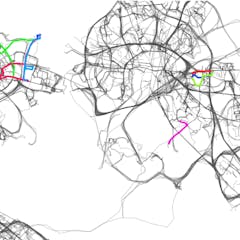
Articles sur Cities
Affichage de 1281 à 1300 de 1508 articles

Landmarks identify and define cities. Town-planning instruments should protect these landmarks from new development that does not respect the setting.

What happens when you find yourself homeless in the countryside?

Wheatley has expertly reimagined Ballard’s futuristic novel in a way that rings true to modern living.

The ‘30-minute city’ goal is about more than urban rail and other transit projects. It means transforming our cities into centres of activity where work, study and services are all close by.

Without the public mobilising over inequalities that are so ingrained in its psyche, Sydney is unlikely to see its nightlife reflect true social inclusion and diversity.

Some economic models tell us that segregation is inevitable. Is it really?

The city, with its carnivalesque excesses, has long been a muse for artists. But Sydney’s lockout laws infantilise its citizens and stifle activity.

How well does the ‘smart’ city respond to the devastating scale and impact of urban heat threats such as bushfires and heatwaves?

Would you take a longer route to work for the good of all?

No wonder you’re always late. Drivers use a route that minimizes travel time on only a third of their trips. Here’s how real-world data can help planners fight traffic congestion.

Effective development planning must anticipate where growth might occur and its wider impacts. So, if the federal government is serious about cities policy, it needs a proper settlements plan.

Under pressure to be a global city, market-led infrastructure provision is shifting the focus from public to private interests, from government as promoter to government as client, with mixed results.

The default position for politicians is to sound concerned about housing affordability, but do nothing. This can be explained by the idea of ‘policy capture’, in this case by industry interests.

Speaking with: Lucy Turnbull on the Greater Sydney Commission
CC BY-ND31,4 Mo (download)
Dallas Rogers speaks with Lucy Turnbull about the new Greater Sydney Commission, its structure, plans and mandate, and the criticisms of what some see as a "top-down" approach to urban planning.

It seems like a ‘no brainer’ to use urban greening to help cities adapt to increasing heat, but the uptake of green infrastructure, such as trees and vegetated roofs, surfaces and walls, is slow. Why?

Here’s how scientists are seeking to turn the building blocks of life into the building blocks of … well, buildings.

Curbing negative gearing will help get empty housing onto the market. This could go some way to bringing life back to relatively dense urban centres that are oddly lacking intensity of public life.

It’s not just a matter of numbers: asylum seekers need houses where they can feel at home.

As consumption has soared and prices have fallen, the realities of industrial chicken farming often clash with the values of people who live on the urban fringes where broiler farms are sited.

Australian cities should be made to work for all inhabitants. This involves evenly spreading the disadvantages of industrial and commercial activities as well as the advantages of good access to services.
